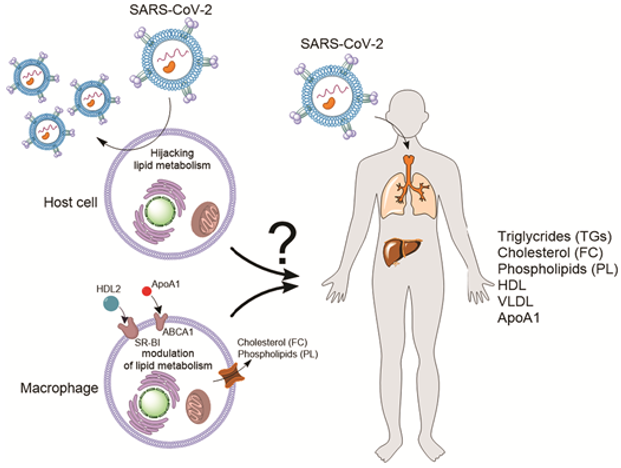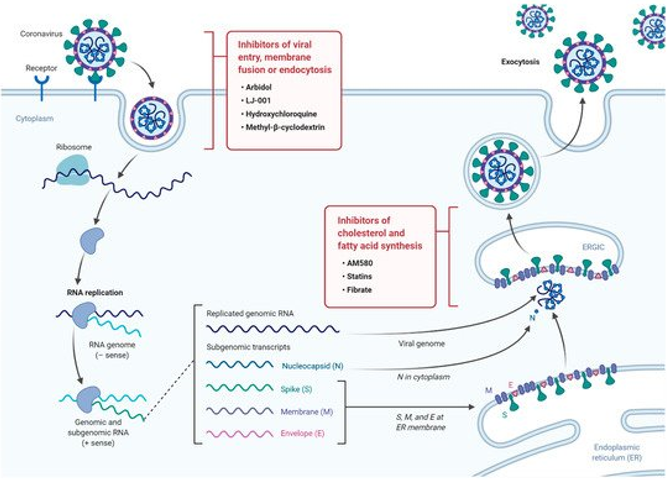Lipidomics in SARS-CoV-2 Infection
The COVID-19 pandemic is spreading globally, with devastating global consequences for social organizations and health care systems. COVID-19 illness is induced by severe acute respiratory syndrome coronavirus type 2 (SARS-CoV-2), which is an enveloped positive single-stranded RNA virus surrounded by a lipid bilayer. Creative Proteomics is an international contract research organization (CRO). We provide state-of-the-art equipment and wide-ranging expertise in biotechnological applications to academic and industry clients. Here, we focus on lipidomics in SARS-CoV-2 infection.
Lipids—key roles in the life cycle of coronaviruses
Similar to other viruses, the host lipid metabolism plays an indispensable role in the life cycle of coronaviruses.
- Lipids in the metabolism and membrane formation of coronaviruses
Coronaviruses utilize host cell intracellular membranes to generate double membrane vesicles (DMVs) for viral genome amplification. Different viruses require specific phospholipid components to form perfect replicating organelles for their replication. DMVs are membranous structures containing viral proteins and an array of hijacked host factors, providing a unique lipid micro-environment ideal for coronavirus replication. Cytosolic phospholipase A2α enzyme (cPLA2α) is a crucial lipid processing enzyme belonging to the phospholipase A2 superfamily. A recent study has demonstrated that cPLA2α plays a critical role in DMVs' formation as well as coronaviruses' replication.
- Lipid in viral internalization
Many viruses, once bound to a target host cell, rely on the endocytosis-mediated pathway in which viral and plasma membranes are facilitated for attachment and fusion. Lipids influence how the virus interacts with receptors during attachment and entry. It has been reported that binding of the free fatty acid linoleic acid (LA) to the SARS-CoV-2 spike glycoprotein-binding domain reduces the SARS-CoV-2 angiotensin-converting enzyme 2 (ACE2) receptor interaction. In addition, lipid rafts are microdomains of the cell membrane containing sphingolipids, cholesterols, and proteins. It is reported that lipid rafts are important for SARS-CoV to enter host cells.
 Fig1. SARS-CoV-2 infects host cells and hijacks lipid metabolism for replication. (Ebrahimi, K. H., & McCullagh, J. S., 2021)
Fig1. SARS-CoV-2 infects host cells and hijacks lipid metabolism for replication. (Ebrahimi, K. H., & McCullagh, J. S., 2021)
Lipid metabolism as a drug target for SARS-CoV-2 infection
Since the rapidly growing Coronavirus Disease (COVID-19) pandemic constitutes a serious global issue, there is an urgent need to develop new treatments and vaccines. Lipids are crucial for the viral life cycle, drugs targeting lipid metabolism can be utilized against viruses, including SARS-CoV-2.
 Fig2. A diagram illustrating the life cycle of SARS-COV2 and potential lipid modifying drugs that can be used as broad-spectrum antiviral drugs to inhibit viral entry, membrane fusion, or endocytosis as well as inhibition of fatty acid and cholesterol synthesis. (Abu-Farha, M., et al, 2020)
Fig2. A diagram illustrating the life cycle of SARS-COV2 and potential lipid modifying drugs that can be used as broad-spectrum antiviral drugs to inhibit viral entry, membrane fusion, or endocytosis as well as inhibition of fatty acid and cholesterol synthesis. (Abu-Farha, M., et al, 2020)
- Targeting lipid metabolism pathways
Lipid metabolism is one of the important pathways in viral replication. The pathways of viral adhesion and fusion as well as viral replication and assembly are the basis of drug discovery. Targeting the lipid metabolism pathways with drugs could constitute an early intervention and exciting therapeutic approach. Inhibitors that inhibit viral cell entry and endocytosis, as well as certain cellular pathways involved in the viral cycle, constitute an important reservoir of antiviral drugs. For example, methyl-β-cyclodextrin (MβCD) can significantly decrease the amount of binding to S protein and ACE2 expression in a dose-dependent manner by depleting cholesterol, thereby reducing SARS-COV replication.
- Targeting lipid synthesis pathways
Lipids play a central role in viral infection, involving envelopment, membrane fusion, and the transformation of viral replication. Drugs that affect lipids such as fatty acid, cholesterol, and sphingolipids, could be targeted to selectively prevent the virus from replicating. For instance, statins (which reduce cholesterol synthesis) and other lipid-lowering drugs have been reported to have beneficial effects on the treatment of COVID-19.
Therefore, a better understanding of the interaction between lipid metabolism and SARS-COV-2 infection is critical to developing new treatments as well as mitigating the social and economic costs of COVID-19 disease. With the rapid development of lipidomics in recent years, such as liquid chromatography-mass spectrometry (LC-MS)-based and high-resolution mass spectrometry (HRMS)-based lipidomic strategy, which has enabled the identification of hundreds and thousands of lipids in biological matrices. Creative Proteomics has been developing metabolomics detection methods and data analysis methods for many years. Based on professional scientists and advanced platforms, we can identify different lipids and determine their alternations in various matrices, including plasma, serum, and urine, and cell extracts. For more information on how we can help you, please feel free to contact us.
References
- Ebrahimi, K. H., & McCullagh, J. S. (2021). "A lipidomic view of SARS-CoV-2." Bioscience Reports, 41(8), BSR20210953.
- Yan, B., et al. (2019). "Characterization of the lipidomic profile of human coronavirus-infected cells: implications for lipid metabolism remodeling upon coronavirus replication." Viruses, 11(1), 73.
- Abu-Farha, M., et al. (2020). "The role of lipid metabolism in COVID-19 virus infection and as a drug target." International Journal of Molecular Sciences, 21(10), 3544.
Related services
* For research use only.

 Fig1. SARS-CoV-2 infects host cells and hijacks lipid metabolism for replication. (Ebrahimi, K. H., & McCullagh, J. S., 2021)
Fig1. SARS-CoV-2 infects host cells and hijacks lipid metabolism for replication. (Ebrahimi, K. H., & McCullagh, J. S., 2021) Fig2. A diagram illustrating the life cycle of SARS-COV2 and potential lipid modifying drugs that can be used as broad-spectrum antiviral drugs to inhibit viral entry, membrane fusion, or endocytosis as well as inhibition of fatty acid and cholesterol synthesis. (Abu-Farha, M., et al, 2020)
Fig2. A diagram illustrating the life cycle of SARS-COV2 and potential lipid modifying drugs that can be used as broad-spectrum antiviral drugs to inhibit viral entry, membrane fusion, or endocytosis as well as inhibition of fatty acid and cholesterol synthesis. (Abu-Farha, M., et al, 2020)